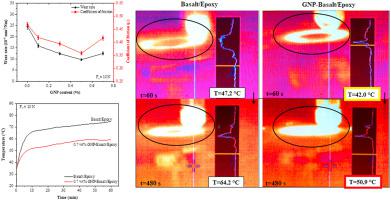Our official English website, www.x-mol.net, welcomes your feedback! (Note: you will need to create a separate account there.)
Graphene nanoplatelet modified basalt/epoxy multi-scale composites with improved tribological performance
Wear ( IF 5 ) Pub Date : 2020-11-01 , DOI: 10.1016/j.wear.2020.203481 Emine Feyza Sukur , Gurol Onal
Wear ( IF 5 ) Pub Date : 2020-11-01 , DOI: 10.1016/j.wear.2020.203481 Emine Feyza Sukur , Gurol Onal

|
Abstract The wear performance of non-toxic and respiratory non-hazardous natural fiber reinforced epoxy composites has steadily become an important design parameter due to their increasing applications in self‐lubricating and sliding components in contact with metal counterparts. Epoxy matrix has weak wear resistance, and reinforcing the matrix with nano-sized particles has been shown to improve the tribological performance of the resulting multi-scale composites. For this, the epoxy matrix was reinforced with various concentrations of GNPs, and the BF/EP composites were fabricated via the vacuum bagging method, subsequently. The tensile strength and modulus were enhanced up to 42.5 and 74.5% compared to the bare BF/EP laminates, respectively. Moreover, the ball-on-disk wear tests revealed that GNP reinforcement was reasonably effective in reducing the coefficient of friction (23%) in contact areas. As a result, GNP reinforced BF/EP composites exhibited 60% higher wear resistance. In addition to well-known solid lubricant characteristics of GNPs, thermal camera recordings were identified that the improved thermal conductivity in all directions was also responsible for the enhanced tribological performance. The microscopic studies identified the related micro-scale mechanisms responsible for the improved tribological performance of the multi-scale composites. We proposed a unique wear mechanism to represent the tribological behavior of the GNP reinforced BF/EP composites based on electron microscopy and thermal camera recordings.
中文翻译:

石墨烯纳米片改性玄武岩/环氧树脂多尺度复合材料具有改善的摩擦学性能
摘要 由于无毒和呼吸无害的天然纤维增强环氧树脂复合材料在自润滑和与金属对应物接触的滑动部件中的应用越来越多,其磨损性能已稳步成为重要的设计参数。环氧树脂基体的耐磨性较弱,用纳米颗粒增强基体已被证明可以改善所得多尺度复合材料的摩擦学性能。为此,环氧树脂基体用不同浓度的 GNP 增强,随后通过真空袋装方法制造 BF/EP 复合材料。与裸 BF/EP 层压板相比,拉伸强度和模量分别提高了 42.5% 和 74.5%。而且,球盘磨损试验表明,GNP 增强在降低接触区域的摩擦系数 (23%) 方面相当有效。因此,GNP 增强的 BF/EP 复合材料的耐磨性提高了 60%。除了众所周知的 GNP 固体润滑剂特性外,热像仪记录还表明,各个方向的导热性提高也是摩擦学性能增强的原因。微观研究确定了导致多尺度复合材料摩擦学性能提高的相关微尺度机制。我们基于电子显微镜和热像仪记录提出了一种独特的磨损机制来表示 GNP 增强的 BF/EP 复合材料的摩擦学行为。GNP 增强 BF/EP 复合材料的耐磨性提高了 60%。除了众所周知的 GNP 固体润滑剂特性外,热像仪记录还表明,各个方向的导热性提高也是摩擦学性能增强的原因。微观研究确定了导致多尺度复合材料摩擦学性能提高的相关微尺度机制。我们基于电子显微镜和热像仪记录提出了一种独特的磨损机制来表示 GNP 增强的 BF/EP 复合材料的摩擦学行为。GNP 增强的 BF/EP 复合材料的耐磨性提高了 60%。除了众所周知的 GNP 固体润滑剂特性外,热像仪记录还表明,各个方向的导热性提高也是摩擦学性能增强的原因。微观研究确定了导致多尺度复合材料摩擦学性能提高的相关微尺度机制。我们基于电子显微镜和热像仪记录提出了一种独特的磨损机制来表示 GNP 增强的 BF/EP 复合材料的摩擦学行为。热成像仪记录表明,各个方向的导热性提高也是摩擦学性能增强的原因。微观研究确定了导致多尺度复合材料摩擦学性能提高的相关微尺度机制。我们基于电子显微镜和热像仪记录提出了一种独特的磨损机制来表示 GNP 增强的 BF/EP 复合材料的摩擦学行为。热成像仪记录表明,各个方向的导热性提高也是摩擦学性能增强的原因。微观研究确定了导致多尺度复合材料摩擦学性能提高的相关微尺度机制。我们基于电子显微镜和热像仪记录提出了一种独特的磨损机制来表示 GNP 增强的 BF/EP 复合材料的摩擦学行为。
更新日期:2020-11-01
中文翻译:

石墨烯纳米片改性玄武岩/环氧树脂多尺度复合材料具有改善的摩擦学性能
摘要 由于无毒和呼吸无害的天然纤维增强环氧树脂复合材料在自润滑和与金属对应物接触的滑动部件中的应用越来越多,其磨损性能已稳步成为重要的设计参数。环氧树脂基体的耐磨性较弱,用纳米颗粒增强基体已被证明可以改善所得多尺度复合材料的摩擦学性能。为此,环氧树脂基体用不同浓度的 GNP 增强,随后通过真空袋装方法制造 BF/EP 复合材料。与裸 BF/EP 层压板相比,拉伸强度和模量分别提高了 42.5% 和 74.5%。而且,球盘磨损试验表明,GNP 增强在降低接触区域的摩擦系数 (23%) 方面相当有效。因此,GNP 增强的 BF/EP 复合材料的耐磨性提高了 60%。除了众所周知的 GNP 固体润滑剂特性外,热像仪记录还表明,各个方向的导热性提高也是摩擦学性能增强的原因。微观研究确定了导致多尺度复合材料摩擦学性能提高的相关微尺度机制。我们基于电子显微镜和热像仪记录提出了一种独特的磨损机制来表示 GNP 增强的 BF/EP 复合材料的摩擦学行为。GNP 增强 BF/EP 复合材料的耐磨性提高了 60%。除了众所周知的 GNP 固体润滑剂特性外,热像仪记录还表明,各个方向的导热性提高也是摩擦学性能增强的原因。微观研究确定了导致多尺度复合材料摩擦学性能提高的相关微尺度机制。我们基于电子显微镜和热像仪记录提出了一种独特的磨损机制来表示 GNP 增强的 BF/EP 复合材料的摩擦学行为。GNP 增强的 BF/EP 复合材料的耐磨性提高了 60%。除了众所周知的 GNP 固体润滑剂特性外,热像仪记录还表明,各个方向的导热性提高也是摩擦学性能增强的原因。微观研究确定了导致多尺度复合材料摩擦学性能提高的相关微尺度机制。我们基于电子显微镜和热像仪记录提出了一种独特的磨损机制来表示 GNP 增强的 BF/EP 复合材料的摩擦学行为。热成像仪记录表明,各个方向的导热性提高也是摩擦学性能增强的原因。微观研究确定了导致多尺度复合材料摩擦学性能提高的相关微尺度机制。我们基于电子显微镜和热像仪记录提出了一种独特的磨损机制来表示 GNP 增强的 BF/EP 复合材料的摩擦学行为。热成像仪记录表明,各个方向的导热性提高也是摩擦学性能增强的原因。微观研究确定了导致多尺度复合材料摩擦学性能提高的相关微尺度机制。我们基于电子显微镜和热像仪记录提出了一种独特的磨损机制来表示 GNP 增强的 BF/EP 复合材料的摩擦学行为。


























 京公网安备 11010802027423号
京公网安备 11010802027423号